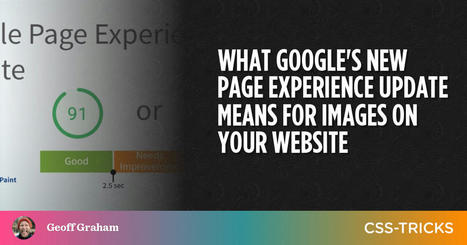It’s easy to forget that, as a search engine, Google doesn’t just compare keywords to generate search results. Google knows that if people don’t enjoy their experience on a web page, they won’t stay on the page long enough to consume the content — no matter how relevant it is.
As a result, Google has been experimenting with ways to analyze the user experience of web pages using quantifiable metrics. Factoring these into its search engine rankings, it’s hoped to provide users not only with great, relevant content but with awesome user experiences as well.
Google’s soon-to-be-launched page experience update is a major step in this direction. Website owners with image-heavy websites need to be particularly vigilant to adapt to these changes or risk falling by the wayside. In this article, we’ll talk about everything you need to know regarding this update, and how you can take full advantage of it.
What is page experience?
In short, it’s a ranking signal that combines data from a number of metrics to try and determine how good or bad the user experience of a web page is. It consists of the following factors:
- Core Web Vitals: Using the same, unchanged, core web vitals. Google has established guidelines and recommended rankings that you can find here. You need an overall “good” CWV rating to qualify for a “good” page experience score.
- Mobile Usability: A URL must have no mobile usability errors to qualify for a “good” page experience score.
- Security Issues: Any flagged security issues will disqualify websites.
- HTTPS: Pages must be served via HTTPS to qualify.
- Ad Experience: Measures to what degree ads negatively affect the user experience on your web page, for example, by being intrusive, distracting, etc.
read more at https://css-tricks.com/what-googles-new-page-experience-update-means-for-images-on-your-website/



 Your new post is loading...
Your new post is loading...








https://acheteractiskenan.com/
https://acheteractiskenan.com/produit/
https://acheteractiskenan.com/produit/achete-klonopin/
https://acheteractiskenan.com/produit/acheter-4-aco-dmt/
https://acheteractiskenan.com/product/acheter-5-meo-dmt-usa/
https://acheteractiskenan.com/product/acheter-dmt/
https://acheteractiskenan.com/product/acheter-adderall-en-ligne/
https://acheteractiskenan.com/product/acheter-adipex/
https://acheteractiskenan.com/product/acheter-toseina-2-ml-solucion/
https://acheteractiskenan.com/product/acheter-oxycodone-mallinckrodt/
https://acheteractiskenan.com/product/acheter-de-loxycodone/
https://acheteractiskenan.com/product/acheter-ativan-en-ligne/
https://acheteractiskenan.com/product/acheter-percocet/
https://acheteractiskenan.com/product/acheter-tramadol/
https://acheteractiskenan.com/product/morphine/
https://acheteractiskenan.com/product/acheter-codeine-en-ligne/
https://acheteractiskenan.com/product/injection-de-morphine/
https://acheteractiskenan.com/product/acheter-phentermine-en-ligne/
https://acheteractiskenan.com/product/acheter-tren-a-en-ligne/
https://acheteractiskenan.com/product/achetez-trenbolone-enanthate/
https://acheteractiskenan.com/product/acheter-trenarapid-en-ligne/
https://acheteractiskenan.com/product/acheter-de-la-cocaine/
https://acheteractiskenan.com/product/acheter-demerol/
https://acheteractiskenan.com/product/acheter-desoxyn/
https://acheteractiskenan.com/product/buy-dexedrine-online/
https://acheteractiskenan.com/product/acheter-dilaudid-en-ligne/
https://acheteractiskenan.com/product/acheter-du-fentanyl/
https://acheteractiskenan.com/product/acheter-du-suboxone/
https://acheteractiskenan.com/product/acheter-du-xanax-vert/
https://acheteractiskenan.com/product/acheter-norvas-10mg/
https://acheteractiskenan.com/product/acheter-oramorph/
https://acheteractiskenan.com/product/acheter-rubifen/
https://acheteractiskenan.com/product/acheter-subutex/
https://acheteractiskenan.com/product/acheter-vicodin/
https://acheteractiskenan.com/product/achetez-vyvanse/
https://acheteractiskenan.com/product/acheter-de-la-cocaine/
https://acheteractiskenan.com/product/acheter-de-lheroine/
https://acheteractiskenan.com/product/acheter-methadone-en-ligne/
https://acheteractiskenan.com/product/acheter-ms-contin/
https://acheteractiskenan.com/product/acheter-oxazepam-en-ligne/
https://acheteractiskenan.com/product/acheter-oxynorm-en-ligne/
https://acheteractiskenan.com/product/acheter-phentermine-en-ligne/
https://acheteractiskenan.com/product/acheter-plegine-en-ligne/
https://acheteractiskenan.com/product/acheter-rubifen/
https://acheteractiskenan.com/product/acheter-stilpane-sirop-100ml/
https://acheteractiskenan.com/product/acheter-toseina-2-ml-solucion/
https://acheteractiskenan.com/product/acheter-histaverin-2-mg-ml/
https://acheteractiskenan.com/product/acheter-lheroine-black-goudron/
https://acheteractiskenan.com/product/acheter-la-cocaine-colombienne/
https://acheteractiskenan.com/product/acheter-ultram-en-ligne/
https://acheteractiskenan.com/product/acheter-oxecta-oxycodone-hcl-...
acheter percocet
acheter tramadol
acheter morphine
acheter codeine en lign
injection de morphine
acheter phentermine en ligne
achetez trenbolone enanthate
acheter trenarapid
kopen nembutal liquid
kopen oxycodon hcl
https://kopenoxycodone.com/
https://kopenoxycodone.com/producten/
https://kopenoxycodone.com/product/ambien-online-kopen/
https://kopenoxycodone.com/product/buprenorfine-kopen/
https://kopenoxycodone.com/product/carisoprodol-nederland-kopen/
https://kopenoxycodone.com/product/fentanyl-citrate-kopen/
https://kopenoxycodone.com/product/fentanyl-poeder-kopen/
https://kopenoxycodone.com/product/fentanyl-pleister-kopen/
https://kopenoxycodone.com/product/gouden-leraar-paddenstoelen/
https://kopenoxycodone.com/product/hydromorphone-kopen/
https://kopenoxycodone.com/product/ketamine-poeder-kopen/
https://kopenoxycodone.com/product/koop-5-meo-dmt/
https://kopenoxycodone.com/product/koop-adderall-online/
https://kopenoxycodone.com/product/koop-desoxyn-online/
https://kopenoxycodone.com/product/koop-dexedrine/
https://kopenoxycodone.com/product/koop-dmt-netherland/
https://kopenoxycodone.com/product/koop-flakka-a-pvp/
https://kopenoxycodone.com/product/koop-mdma-crystal/
https://kopenoxycodone.com/product/koop-morphine/
https://kopenoxycodone.com/product/koop-natriumcyanide/
https://kopenoxycodone.com/product/koop-nembutal-pentobarbital/
https://kopenoxycodone.com/product/koop-nembutal-poeder/
https://kopenoxycodone.com/product/koop-oxycodon/
https://kopenoxycodone.com/product/koop-oxycontin-online/
https://kopenoxycodone.com/product/koop-percocet-online/
https://kopenoxycodone.com/product/koop-phentermine-adipex/
https://kopenoxycodone.com/product/koop-suboxone-strips/
https://kopenoxycodone.com/product/koop-subutex-nederlands/
https://kopenoxycodone.com/product/koop-vicodin-online/
https://kopenoxycodone.com/product/koop-vyvanse-online/
https://kopenoxycodone.com/product/kopen-ultram-online/
https://kopenoxycodone.com/product/lsd-sheet/
https://kopenoxycodone.com/product/nembutal-pillen-kopen/
https://kopenoxycodone.com/product/koop-nembutal-liquid/
https://kopenoxycodone.com/product/oxycodon-hcl-kopen/
comprar-ultram
comprar xanax verde
buy xanax
comprar vyvanse en linea
comprar vicodin en linea
golden teacher
comprar psilocybe
comprar polvo-
comprar micro mushrooms
comprar metanfetaminas
comprar flakka
comprar fentanilo en linea
comprar extasis en linea
comprar-etizolam
comprar-5-meo-dmt
buy-seconal-sodium
buy-nembutal-pills
buy-nembutal-liquid
Oxycodone
comprar Oxycodone
https://comprarmorfina.com/
https://comprarmorfina.com/productos-comprar-dilaudid/
https://comprarmorfina.com/product/comprar-adderall-en-linea/
https://comprarmorfina.com/product/comprar-adipex-en-linea/
https://comprarmorfina.com/product/comprar-ambien-en-linea/
https://comprarmorfina.com/product/comprar-buprenorfine-en-linea/
https://comprarmorfina.com/product/comprar-dexedrina/
https://comprarmorfina.com/product/comprar-desoxyn-en-linea/
https://comprarmorfina.com/product/comprar-dilaudid/
https://comprarmorfina.com/product/comprar-dmt-en-linea/
https://comprarmorfina.com/product/comprar-heroina-en-linea/
https://comprarmorfina.com/product/comprar-ketamina/
https://comprarmorfina.com/product/comprar-klonopin/
https://comprarmorfina.com/product/comprar-morfina/
https://comprarmorfina.com/product/comprar-oxicodona-en-linea/
https://comprarmorfina.com/product/comprar-oxycontin-en-linea/
https://comprarmorfina.com/product/comprar-percocet-en-linea/
https://comprarmorfina.com/product/comprar-rubifen-espana/
https://comprarmorfina.com/product/comprar-soma-en-linea/
https://comprarmorfina.com/product/comprar-suboxone-en-linea/
https://comprarmorfina.com/product/comprar-subutex-en-linea/
https://comprarmorfina.com/product/comprar-ultram-en-linea/
https://comprarmorfina.com/product/comprar-xanax-verde/
https://comprarmorfina.com/product/buy-xanax/
https://comprarmorfina.com/product/comprar-vyvanse-en-linea/
https://comprarmorfina.com/product/comprar-vicodin-en-linea/
https://comprarmorfina.com/product/golden-teacher-crecer-rapidamente/https://onlinevapesshop.com/
https://onlinevapesshop.com/product/
https://onlinevapesshop.com/product/buy-phentermine-online/
https://onlinevapesshop.com/product/buy-adipex-online/
https://onlinevapesshop.com/product/buy-oxynorm-online/
https://onlinevapesshop.com/product/buy-oxycontin-online/
https://onlinevapesshop.com/product/buy-adderall-online-3/
https://onlinevapesshop.com/product/buy-adderall-online-2/
https://onlinevapesshop.com/product/buy-celexa-online/
https://onlinevapesshop.com/product/buy-concerta-online/
https://onlinevapesshop.com/product/buy-desoxyn-5mg-online/
https://onlinevapesshop.com/product/buy-dexedrine-online/
https://onlinevapesshop.com/product/buy-klonopin-online/
https://onlinevapesshop.com/product/buy-mescaline-online/
https://onlinevapesshop.com/product/buy-valium-online/
https://onlinevapesshop.com/product/buy-xanax-online/
https://onlinevapesshop.com/product/buy-yellow-xanax-bars-online/
https://onlinevapesshop.com/product/buy-zopiclone-online/
https://onlinevapesshop.com/product/buy-botox-online/
https://onlinevapesshop.com/product/buy-cbd-oil-online/
https://onlinevapesshop.com/product/buy-diclazepam-online/
https://onlinevapesshop.com/product/buy-liquid-red-mercury-online/
https://onlinevapesshop.com/product/buy-mdma-crystal-online/
https://onlinevapesshop.com/product/buy-phenylacetone-oil-online/
https://onlinevapesshop.com/product/buy-nembutal-pentobarbital-liqu...
https://onlinevapesshop.com/product/buy-piperonyl-methyl-ketone/
https://onlinevapesshop.com/product/buy-anavar-oxandrolone-online/
https://onlinevapesshop.com/product/buy-ssd-chemical-solution/
https://onlinevapesshop.com/product/buy-ayurvedic-urea-online/
https://onlinevapesshop.com/product/buy-dxn-code-strike-online/
https://onlinevapesshop.com/product/buy-deca-durabolin-online/
https://onlinevapesshop.com/product/buy-viagra-online/
https://onlinevapesshop.com/product/buy-genius-test-online/
https://onlinevapesshop.com/product/buy-viagra-online/
https://onlinevapesshop.com/product-category/growth-hormones/
https://onlinevapesshop.com/product/buy-viagra-online/
https://onlinevapesshop.com/product/buy-ketamine-liquid-online/
https://onlinevapesshop.com/product/buy-ketamine-powder-online/
https://onlinevapesshop.com/product/buy-methoxetamine-online/
https://onlinevapesshop.com/product/buy-methylone-crystals-online/
https://onlinevapesshop.com/product/buy-morphine-online-2/
https://onlinevapesshop.com/product/buy-oramorph-online/
https://onlinevapesshop.com/product/buy-percocet-online/
https://onlinevapesshop.com/product/buy-roxicodone-online/
https://onlinevapesshop.com/product/buy-soma-online/
https://onlinevapesshop.com/product/buy-tramadol-online/
https://onlinevapesshop.com/product/buy-vicodin-online/
Buy oxycodone online
Buy phentermine online
Buy adipex online
Buy oxynorm online
Buy oxycontin online
Buy adderall USA online
Buy adderall online
Buy oxycodone online
Buy 4-aco-dmt online
Buy 5-meo-dmt online
Buy adipex online
Buy ambien online
Buy oxycodone
buy oxycontin
buy percocet
buy oramorph
Buy oxycodone online
buy-nembutal liquid
https://dolorendo.com/
https://dolorendo.com/product/
https://dolorendo.com/product/comprar-oxicodona-en-linea/
https://dolorendo.com/product/comprar-oxicodon/
https://dolorendo.com/product/comprar-oxynorm-en-linea/
https://dolorendo.com/product/comprar-oxycontin-en-linea/
https://dolorendo.com/product/comprar-percocet-en-linea/
https://dolorendo.com/product/comprar-oramorph-sr/
https://dolorendo.com/productos-comprar-dilaudid/
https://dolorendo.com/product/comprar-vyvanse-en-linea/
https://dolorendo.com/product/comprar-suboxone-en-linea/
https://dolorendo.com/product/comprar-subutex-en-linea/
https://dolorendo.com/product/comprar-pastillas-nembutal/
https://dolorendo.com/productos-comprar-dilaudid/
https://dolorendo.com/product/comprar-acetaminofen-codeina/
https://dolorendo.com/product/comprar-adderall-en-linea/
https://dolorendo.com/product/comprar-desoxyn-en-linea/
https://dolorendo.com/product/comprar-dexedrina/
https://dolorendo.com/product/comprar-dmt-en-linea/
https://dolorendo.com/product/comprar-ketamina/
https://dolorendo.com/product/comprar-klonopin/
https://dolorendo.com/product/comprar-5-meo-dmt/
https://dolorendo.com/product/comprar-adipex-en-linea/
https://dolorendo.com/product/comprar-alphabol-cr/
https://buypsychedelicsnow.com/shop/buy-morphine-canada/
https://buypsychedelicsnow.com/shop/buy-5-meo-dmt-usa/
https://buypsychedelicsnow.com/shop/buy-codeine-online/
https://buypsychedelicsnow.com/shop/buy-4-aco-dmt-online/
https://buypsychedelicsnow.com/shop/buy-ayahuasca-online-usa/
https://buypsychedelicsnow.com/shop/black-tar-heroin/
https://buypsychedelicsnow.com/shop/buy-bolivian-cocaine/
https://buypsychedelicsnow.com/shop/buy-brown-heroin-usa/
https://buypsychedelicsnow.com/shop/buy-changa-online/
https://buypsychedelicsnow.com/shop/buy-white-heroin-online/
https://buypsychedelicsnow.com/shop/buy-dmt-online-canada/
https://buypsychedelicsnow.com/shop/buy-flakka-online/
https://buypsychedelicsnow.com/shop/buy-psilocybe-cubensis-online/
https://buypsychedelicsnow.com/shop/buy-ibogaine-online-canada/
https://buypsychedelicsnow.com/shop/ketamine-powder-for-sale/
https://buypsychedelicsnow.com/shop/buy-kratom-online-canada/
https://buypsychedelicsnow.com/shop/buy-lsd-online-canada/
https://buypsychedelicsnow.com/shop/mdma-for-sale-canada/
https://buypsychedelicsnow.com/shop/buy-mescaline-online-canada/
https://buypsychedelicsnow.com/shop/buy-mushroom-online-canada/
https://buypsychedelicsnow.com/shop/buy-psilocybin-online-canada/
https://acheteractiskenan.com/
https://acheteractiskenan.com/produit/
https://acheteractiskenan.com/produit/achete-klonopin/
https://acheteractiskenan.com/produit/acheter-4-aco-dmt/
https://acheteractiskenan.com/product/acheter-5-meo-dmt-usa/
https://acheteractiskenan.com/product/acheter-dmt/
https://acheteractiskenan.com/product/acheter-adderall-en-ligne/
https://acheteractiskenan.com/product/acheter-adipex/
https://acheteractiskenan.com/product/acheter-toseina-2-ml-solucion/
https://acheteractiskenan.com/product/acheter-oxycodone-mallinckrodt/
https://acheteractiskenan.com/product/acheter-de-loxycodone/
https://acheteractiskenan.com/product/acheter-ativan-en-ligne/
https://acheteractiskenan.com/product/acheter-percocet/
https://acheteractiskenan.com/product/acheter-tramadol/
https://acheteractiskenan.com/product/morphine/
https://acheteractiskenan.com/product/acheter-codeine-en-ligne/
https://acheteractiskenan.com/product/injection-de-morphine/
https://acheteractiskenan.com/product/acheter-phentermine-en-ligne/
https://acheteractiskenan.com/product/acheter-tren-a-en-ligne/
https://acheteractiskenan.com/product/achetez-trenbolone-enanthate/
https://acheteractiskenan.com/product/acheter-trenarapid-en-ligne/
https://acheteractiskenan.com/product/acheter-de-la-cocaine/
https://acheteractiskenan.com/product/acheter-demerol/
https://acheteractiskenan.com/product/acheter-desoxyn/
https://acheteractiskenan.com/product/buy-dexedrine-online/
https://acheteractiskenan.com/product/acheter-dilaudid-en-ligne/
https://acheteractiskenan.com/product/acheter-du-fentanyl/
https://acheteractiskenan.com/product/acheter-du-suboxone/
https://acheteractiskenan.com/product/acheter-du-xanax-vert/
https://acheteractiskenan.com/product/acheter-norvas-10mg/
https://acheteractiskenan.com/product/acheter-oramorph/
https://acheteractiskenan.com/product/acheter-rubifen/
https://acheteractiskenan.com/product/acheter-subutex/
https://acheteractiskenan.com/product/acheter-vicodin/
https://acheteractiskenan.com/product/achetez-vyvanse/
https://acheteractiskenan.com/product/acheter-de-la-cocaine/
https://acheteractiskenan.com/product/acheter-de-lheroine/
https://acheteractiskenan.com/product/acheter-methadone-en-ligne/
https://acheteractiskenan.com/product/acheter-ms-contin/
https://acheteractiskenan.com/product/acheter-oxazepam-en-ligne/
https://acheteractiskenan.com/product/acheter-oxynorm-en-ligne/
https://acheteractiskenan.com/product/acheter-phentermine-en-ligne/
https://acheteractiskenan.com/product/acheter-plegine-en-ligne/
https://acheteractiskenan.com/product/acheter-rubifen/
https://acheteractiskenan.com/product/acheter-stilpane-sirop-100ml/
https://acheteractiskenan.com/product/acheter-toseina-2-ml-solucion/
https://acheteractiskenan.com/product/acheter-histaverin-2-mg-ml/
https://acheteractiskenan.com/product/acheter-lheroine-black-goudron/
https://acheteractiskenan.com/product/acheter-la-cocaine-colombienne/
https://acheteractiskenan.com/product/acheter-ultram-en-ligne/
https://acheteractiskenan.com/product/acheter-oxecta-oxycodone-hcl-...
acheter percocet
acheter tramadol
acheter morphine
acheter codeine en lign
injection de morphine
acheter phentermine en ligne
achetez trenbolone enanthate
acheter trenarapid
kopen nembutal liquid
kopen oxycodon hcl
https://kopenoxycodone.com/
https://kopenoxycodone.com/producten/
https://kopenoxycodone.com/product/ambien-online-kopen/
https://kopenoxycodone.com/product/buprenorfine-kopen/
https://kopenoxycodone.com/product/carisoprodol-nederland-kopen/
https://kopenoxycodone.com/product/fentanyl-citrate-kopen/
https://kopenoxycodone.com/product/fentanyl-poeder-kopen/
https://kopenoxycodone.com/product/fentanyl-pleister-kopen/
https://kopenoxycodone.com/product/gouden-leraar-paddenstoelen/
https://kopenoxycodone.com/product/hydromorphone-kopen/
https://kopenoxycodone.com/product/ketamine-poeder-kopen/
https://kopenoxycodone.com/product/koop-5-meo-dmt/
https://kopenoxycodone.com/product/koop-adderall-online/
https://kopenoxycodone.com/product/koop-desoxyn-online/
https://kopenoxycodone.com/product/koop-dexedrine/
https://kopenoxycodone.com/product/koop-dmt-netherland/
https://kopenoxycodone.com/product/koop-flakka-a-pvp/
https://kopenoxycodone.com/product/koop-mdma-crystal/
https://kopenoxycodone.com/product/koop-morphine/
https://kopenoxycodone.com/product/koop-natriumcyanide/
https://kopenoxycodone.com/product/koop-nembutal-pentobarbital/
https://kopenoxycodone.com/product/koop-nembutal-poeder/
https://kopenoxycodone.com/product/koop-oxycodon/
https://kopenoxycodone.com/product/koop-oxycontin-online/
https://kopenoxycodone.com/product/koop-percocet-online/
https://kopenoxycodone.com/product/koop-phentermine-adipex/
https://kopenoxycodone.com/product/koop-suboxone-strips/
https://kopenoxycodone.com/product/koop-subutex-nederlands/
https://kopenoxycodone.com/product/koop-vicodin-online/
https://kopenoxycodone.com/product/koop-vyvanse-online/
https://kopenoxycodone.com/product/kopen-ultram-online/
https://kopenoxycodone.com/product/lsd-sheet/
https://kopenoxycodone.com/product/nembutal-pillen-kopen/
https://kopenoxycodone.com/product/koop-nembutal-liquid/
https://kopenoxycodone.com/product/oxycodon-hcl-kopen/
comprar-ultram
comprar xanax verde
buy xanax
comprar vyvanse en linea
comprar vicodin en linea
golden teacher
comprar psilocybe
comprar polvo-
comprar micro mushrooms
comprar metanfetaminas
comprar flakka
comprar fentanilo en linea
comprar extasis en linea
comprar-etizolam
comprar-5-meo-dmt
buy-seconal-sodium
buy-nembutal-pills
buy-nembutal-liquid
Oxycodone
comprar Oxycodone
https://comprarmorfina.com/
https://comprarmorfina.com/productos-comprar-dilaudid/
https://comprarmorfina.com/product/comprar-adderall-en-linea/
https://comprarmorfina.com/product/comprar-adipex-en-linea/
https://comprarmorfina.com/product/comprar-ambien-en-linea/
https://comprarmorfina.com/product/comprar-buprenorfine-en-linea/
https://comprarmorfina.com/product/comprar-dexedrina/
https://comprarmorfina.com/product/comprar-desoxyn-en-linea/
https://comprarmorfina.com/product/comprar-dilaudid/
https://comprarmorfina.com/product/comprar-dmt-en-linea/
https://comprarmorfina.com/product/comprar-heroina-en-linea/
https://comprarmorfina.com/product/comprar-ketamina/
https://comprarmorfina.com/product/comprar-klonopin/
https://comprarmorfina.com/product/comprar-morfina/
https://comprarmorfina.com/product/comprar-oxicodona-en-linea/
https://comprarmorfina.com/product/comprar-oxycontin-en-linea/
https://comprarmorfina.com/product/comprar-percocet-en-linea/
https://comprarmorfina.com/product/comprar-rubifen-espana/
https://comprarmorfina.com/product/comprar-soma-en-linea/
https://comprarmorfina.com/product/comprar-suboxone-en-linea/
https://comprarmorfina.com/product/comprar-subutex-en-linea/
https://comprarmorfina.com/product/comprar-ultram-en-linea/
https://comprarmorfina.com/product/comprar-xanax-verde/
https://comprarmorfina.com/product/buy-xanax/
https://comprarmorfina.com/product/comprar-vyvanse-en-linea/
https://comprarmorfina.com/product/comprar-vicodin-en-linea/
https://comprarmorfina.com/product/golden-teacher-crecer-rapidamente/https://onlinevapesshop.com/
https://onlinevapesshop.com/product/
https://onlinevapesshop.com/product/buy-phentermine-online/
https://onlinevapesshop.com/product/buy-adipex-online/
https://onlinevapesshop.com/product/buy-oxynorm-online/
https://onlinevapesshop.com/product/buy-oxycontin-online/
https://onlinevapesshop.com/product/buy-adderall-online-3/
https://onlinevapesshop.com/product/buy-adderall-online-2/
https://onlinevapesshop.com/product/buy-celexa-online/
https://onlinevapesshop.com/product/buy-concerta-online/
https://onlinevapesshop.com/product/buy-desoxyn-5mg-online/
https://onlinevapesshop.com/product/buy-dexedrine-online/
https://onlinevapesshop.com/product/buy-klonopin-online/
https://onlinevapesshop.com/product/buy-mescaline-online/
https://onlinevapesshop.com/product/buy-valium-online/
https://onlinevapesshop.com/product/buy-xanax-online/
https://onlinevapesshop.com/product/buy-yellow-xanax-bars-online/
https://onlinevapesshop.com/product/buy-zopiclone-online/
https://onlinevapesshop.com/product/buy-botox-online/
https://onlinevapesshop.com/product/buy-cbd-oil-online/
https://onlinevapesshop.com/product/buy-diclazepam-online/
https://onlinevapesshop.com/product/buy-liquid-red-mercury-online/
https://onlinevapesshop.com/product/buy-mdma-crystal-online/
https://onlinevapesshop.com/product/buy-phenylacetone-oil-online/
https://onlinevapesshop.com/product/buy-nembutal-pentobarbital-liqu...
https://onlinevapesshop.com/product/buy-piperonyl-methyl-ketone/
https://onlinevapesshop.com/product/buy-anavar-oxandrolone-online/
https://onlinevapesshop.com/product/buy-ssd-chemical-solution/
https://onlinevapesshop.com/product/buy-ayurvedic-urea-online/
https://onlinevapesshop.com/product/buy-dxn-code-strike-online/
https://onlinevapesshop.com/product/buy-deca-durabolin-online/
https://onlinevapesshop.com/product/buy-viagra-online/
https://onlinevapesshop.com/product/buy-genius-test-online/
https://onlinevapesshop.com/product/buy-viagra-online/
https://onlinevapesshop.com/product-category/growth-hormones/
https://onlinevapesshop.com/product/buy-viagra-online/
https://onlinevapesshop.com/product/buy-ketamine-liquid-online/
https://onlinevapesshop.com/product/buy-ketamine-powder-online/
https://onlinevapesshop.com/product/buy-methoxetamine-online/
https://onlinevapesshop.com/product/buy-methylone-crystals-online/
https://onlinevapesshop.com/product/buy-morphine-online-2/
https://onlinevapesshop.com/product/buy-oramorph-online/
https://onlinevapesshop.com/product/buy-percocet-online/
https://onlinevapesshop.com/product/buy-roxicodone-online/
https://onlinevapesshop.com/product/buy-soma-online/
https://onlinevapesshop.com/product/buy-tramadol-online/
https://onlinevapesshop.com/product/buy-vicodin-online/
Buy oxycodone online
Buy phentermine online
Buy adipex online
Buy oxynorm online
Buy oxycontin online
Buy adderall USA online
Buy adderall online
Buy oxycodone online
Buy 4-aco-dmt online
Buy 5-meo-dmt online
Buy adipex online
Buy ambien online
Buy oxycodone
buy oxycontin
buy percocet
buy oramorph
Buy oxycodone online
buy-nembutal liquid
https://dolorendo.com/
https://dolorendo.com/product/
https://dolorendo.com/product/comprar-oxicodona-en-linea/
https://dolorendo.com/product/comprar-oxicodon/
https://dolorendo.com/product/comprar-oxynorm-en-linea/
https://dolorendo.com/product/comprar-oxycontin-en-linea/
https://dolorendo.com/product/comprar-percocet-en-linea/
https://dolorendo.com/product/comprar-oramorph-sr/
https://dolorendo.com/productos-comprar-dilaudid/
https://dolorendo.com/product/comprar-vyvanse-en-linea/
https://dolorendo.com/product/comprar-suboxone-en-linea/
https://dolorendo.com/product/comprar-subutex-en-linea/
https://dolorendo.com/product/comprar-pastillas-nembutal/
https://dolorendo.com/productos-comprar-dilaudid/
https://dolorendo.com/product/comprar-acetaminofen-codeina/
https://dolorendo.com/product/comprar-adderall-en-linea/
https://dolorendo.com/product/comprar-desoxyn-en-linea/
https://dolorendo.com/product/comprar-dexedrina/
https://dolorendo.com/product/comprar-dmt-en-linea/
https://dolorendo.com/product/comprar-ketamina/
https://dolorendo.com/product/comprar-klonopin/
https://dolorendo.com/product/comprar-5-meo-dmt/
https://dolorendo.com/product/comprar-adipex-en-linea/
https://dolorendo.com/product/comprar-alphabol-cr/
https://buypsychedelicsnow.com/shop/buy-morphine-canada/
https://buypsychedelicsnow.com/shop/buy-5-meo-dmt-usa/
https://buypsychedelicsnow.com/shop/buy-codeine-online/
https://buypsychedelicsnow.com/shop/buy-4-aco-dmt-online/
https://buypsychedelicsnow.com/shop/buy-ayahuasca-online-usa/
https://buypsychedelicsnow.com/shop/black-tar-heroin/
https://buypsychedelicsnow.com/shop/buy-bolivian-cocaine/
https://buypsychedelicsnow.com/shop/buy-brown-heroin-usa/
https://buypsychedelicsnow.com/shop/buy-changa-online/
https://buypsychedelicsnow.com/shop/buy-white-heroin-online/
https://buypsychedelicsnow.com/shop/buy-dmt-online-canada/
https://buypsychedelicsnow.com/shop/buy-flakka-online/
https://buypsychedelicsnow.com/shop/buy-psilocybe-cubensis-online/
https://buypsychedelicsnow.com/shop/buy-ibogaine-online-canada/
https://buypsychedelicsnow.com/shop/ketamine-powder-for-sale/
https://buypsychedelicsnow.com/shop/buy-kratom-online-canada/
https://buypsychedelicsnow.com/shop/buy-lsd-online-canada/
https://buypsychedelicsnow.com/shop/mdma-for-sale-canada/
https://buypsychedelicsnow.com/shop/buy-mescaline-online-canada/
https://buypsychedelicsnow.com/shop/buy-mushroom-online-canada/
https://buypsychedelicsnow.com/shop/buy-psilocybin-online-canada/
https://hangover.com.hk